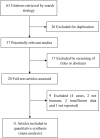Efficacy of continuous positive airway pressure on TNF-α in obstructive sleep apnea patients: A meta-analysis
- PMID: 36952521
- PMCID: PMC10035913
- DOI: 10.1371/journal.pone.0282172
Efficacy of continuous positive airway pressure on TNF-α in obstructive sleep apnea patients: A meta-analysis
Abstract
Background: Tumor necrosis factor-α (TNF-α) is an important mediator of the immune response. At present, the improvement of TNF-α after continuous positive airway pressure (CPAP) treatment of obstructive sleep apnea-hypopnea syndrome (OSAHS) is still controversial.
Methods: We conducted a systematic review of the present evidence based on a meta-analysis to elucidate the effects of TNF-α on OSAHS after CPAP treatment.
Results: To measure TNF-α, ten studies used enzyme-linked immunosorbent assay (ELISA), and one used radioimmunoassay. The forest plot outcome indicated that CPAP therapy would lower the TNF-α levels in OSAHS patients, with a weighted mean difference (WMD) of 1.08 (95% CI: 0.62-1.55; P < 0.001) based on the REM since there is highly significant heterogeneity (I2 = 90%) among the studies. Therefore, we used the subgroup and sensitivity analyses to investigate the source of heterogeneity. The findings of the sensitivity analysis revealed that the pooled WMD ranged from 0.91 (95% CI: 0.52-1.31; P < 0.001) to 1.18 (95% CI: 0.74-1.63; P < 0.001). The findings were not influenced by any single study. Notably, there was homogeneity in the Asia subgroup and publication year: 2019, implying that these subgroups could be the source of heterogeneity.
Conclusion: Our meta-analysis recommends that CPAP therapy will decrease the TNF-α level in OSAHS patients, but more related research should be conducted.
Copyright: © 2023 Luo et al. This is an open access article distributed under the terms of the Creative Commons Attribution License, which permits unrestricted use, distribution, and reproduction in any medium, provided the original author and source are credited.
Conflict of interest statement
The authors have declared that no competing interests exist.
Figures
Similar articles
-
[Association of obstructive sleep apnea hypopnea syndrome with carotid atherosclerosis and the efficacy of continuous positive airway pressure treatment].Zhonghua Yi Xue Za Zhi. 2015 Sep 8;95(34):2791-5. Zhonghua Yi Xue Za Zhi. 2015. PMID: 26711980 Chinese.
-
Efficacy of continuous positive airway pressure on NT-pro-BNP in obstructive sleep apnea patients: a meta-analysis.BMC Pulm Med. 2023 Jul 14;23(1):260. doi: 10.1186/s12890-023-02539-9. BMC Pulm Med. 2023. PMID: 37452327 Free PMC article.
-
[Association between inflammation and cognitive function and effects of continuous positive airway pressure treatment in obstructive sleep apnea hypopnea syndrome].Zhonghua Yi Xue Za Zhi. 2014 Dec 2;94(44):3483-7. Zhonghua Yi Xue Za Zhi. 2014. PMID: 25622738 Chinese.
-
Efficacy of continuous positive airway pressure (CPAP) preventing type 2 diabetes mellitus in patients with obstructive sleep apnea hypopnea syndrome (OSAHS) and insulin resistance: a systematic review and meta-analysis.Sleep Med. 2019 Oct;62:14-21. doi: 10.1016/j.sleep.2018.12.017. Epub 2019 Jan 7. Sleep Med. 2019. PMID: 31518943
-
Association between elevated homocysteine levels and obstructive sleep apnea hypopnea syndrome: a systematic review and updated meta-analysis.Front Endocrinol (Lausanne). 2024 Jun 3;15:1378293. doi: 10.3389/fendo.2024.1378293. eCollection 2024. Front Endocrinol (Lausanne). 2024. PMID: 38887264 Free PMC article.
Cited by
-
Effects of continuous positive airway pressure therapy on inflammatory markers in patients with obstructive sleep apnea: a meta-analysis of randomized controlled trials.Sleep Breath. 2025 May 9;29(2):182. doi: 10.1007/s11325-025-03348-6. Sleep Breath. 2025. PMID: 40346316 Free PMC article. Review.
-
Obstructive sleep apnea is a risk factor for incident COVID-19 infection.Sleep Breath. 2025 Jun 25;29(4):226. doi: 10.1007/s11325-025-03401-4. Sleep Breath. 2025. PMID: 40560295 No abstract available.
-
Association Between Sleep Apnea Syndrome and Osteoarthritis: Insights from Bidirectional Mendelian Randomization and Bioinformatics Analysis.Nat Sci Sleep. 2024 May 7;16:473-487. doi: 10.2147/NSS.S461010. eCollection 2024. Nat Sci Sleep. 2024. PMID: 38737460 Free PMC article.
References
-
- Lam C M, Lui M S, Ip S M (2010) Diabetes and metabolic aspects of OSA. Sleep Apnoea:189–215.
Publication types
MeSH terms
Substances
LinkOut - more resources
Full Text Sources



